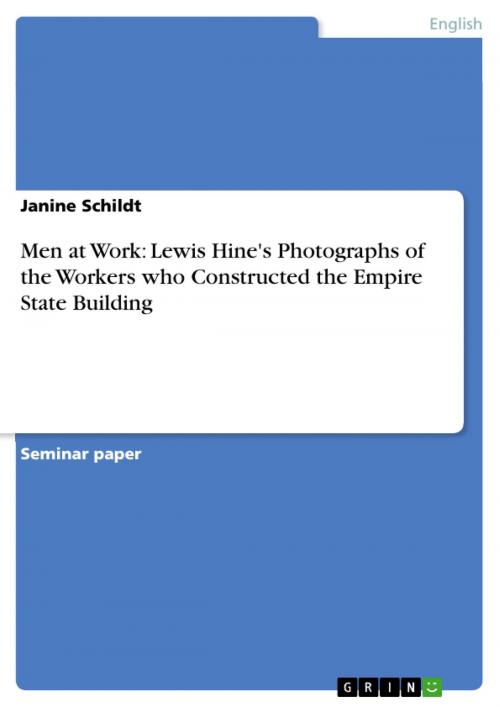Men at Work: Lewis Hine's Photographs of the Workers who Constructed the Empire State Building
Nonfiction, Entertainment, Drama, Anthologies| Author: | Janine Schildt | ISBN: | 9783638601719 |
| Publisher: | GRIN Verlag | Publication: | January 20, 2007 |
| Imprint: | GRIN Verlag | Language: | English |
| Author: | Janine Schildt |
| ISBN: | 9783638601719 |
| Publisher: | GRIN Verlag |
| Publication: | January 20, 2007 |
| Imprint: | GRIN Verlag |
| Language: | English |
Seminar paper from the year 2005 in the subject American Studies - Culture and Applied Geography, grade: 1,0, Martin Luther University (Institut für Anglistik-und Amerikanistik), course: American Photography, 11 entries in the bibliography, language: English, abstract: On March 17, 1930 a construction marathon began to build the tallest skyscraper on the planet. The erecting of a building that was even before its termination determined to become an American landmark was of course an interesting working field for contemporary photographers like Alfred Stieglitz and Lewis Wickes Hine. But while the first pictured the gigantic buildings in New York, the latter took a different focus in his work. In the same way as in his earlier photographs of immigrants entering Ellis Island and children working day and night in American factories, Hine focused on the people in his later work. In his book'Men at Work: Photographic Studies of Modern Men and Machines'he portrayed the workers constructing the Empire State Building and he looked behind the walls and steel beams to honor the people who made such an architectural wonder possible. Other aspects of his late project nevertheless appear contradictory comparing them to his early landmarks of social photography. In the'Men at Work'pictures he praises the modern worker as the centre of a new technologic, clearly capitalist era, neglecting the social reality of the Great Depression. How can Lewis Hine suddenly promote capitalism, without showing the other side of the medal - the unemployed, the socially excluded, the poor? For what reason did he not continue to portray the under-dogs of the system, picturing broke farmers in the Mid-West or unemployed workers lining up on New York's streets, but instead started promotion work for big capitalist like John Jakob Raskob? This paper will look at four pictures from Hine's'Men at Work'series on the construction of the Empire State Building taken during a six-month-period between 1930 and 1931. It will interpret them in their social context, trying to point out the intention of the photographer. Hine's portraits will be discussed looking for reasons for the change of focus in his work. To conclude the paper, the question will be asked if this late series is really a break in his work or not rather a completion of an overall task. The photographs discussed in this paper were taken from Lewis Hine's book'Men at Work: Studies of Modern Men and Machines'and the pictorial 'The Empire State Building' edited by Claudine Weber-Hof.
Seminar paper from the year 2005 in the subject American Studies - Culture and Applied Geography, grade: 1,0, Martin Luther University (Institut für Anglistik-und Amerikanistik), course: American Photography, 11 entries in the bibliography, language: English, abstract: On March 17, 1930 a construction marathon began to build the tallest skyscraper on the planet. The erecting of a building that was even before its termination determined to become an American landmark was of course an interesting working field for contemporary photographers like Alfred Stieglitz and Lewis Wickes Hine. But while the first pictured the gigantic buildings in New York, the latter took a different focus in his work. In the same way as in his earlier photographs of immigrants entering Ellis Island and children working day and night in American factories, Hine focused on the people in his later work. In his book'Men at Work: Photographic Studies of Modern Men and Machines'he portrayed the workers constructing the Empire State Building and he looked behind the walls and steel beams to honor the people who made such an architectural wonder possible. Other aspects of his late project nevertheless appear contradictory comparing them to his early landmarks of social photography. In the'Men at Work'pictures he praises the modern worker as the centre of a new technologic, clearly capitalist era, neglecting the social reality of the Great Depression. How can Lewis Hine suddenly promote capitalism, without showing the other side of the medal - the unemployed, the socially excluded, the poor? For what reason did he not continue to portray the under-dogs of the system, picturing broke farmers in the Mid-West or unemployed workers lining up on New York's streets, but instead started promotion work for big capitalist like John Jakob Raskob? This paper will look at four pictures from Hine's'Men at Work'series on the construction of the Empire State Building taken during a six-month-period between 1930 and 1931. It will interpret them in their social context, trying to point out the intention of the photographer. Hine's portraits will be discussed looking for reasons for the change of focus in his work. To conclude the paper, the question will be asked if this late series is really a break in his work or not rather a completion of an overall task. The photographs discussed in this paper were taken from Lewis Hine's book'Men at Work: Studies of Modern Men and Machines'and the pictorial 'The Empire State Building' edited by Claudine Weber-Hof.















